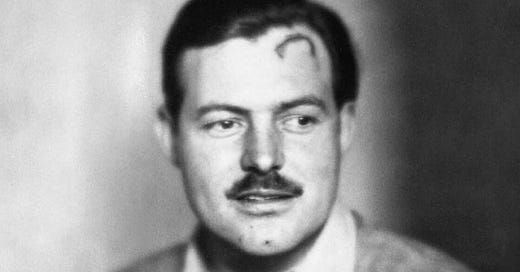Ernest Hemingway immerses the reader in Nick’s point of view in “Indian Camp.” The writer chooses to focus on Nick’s experience during a single day. Late in the story, Nick is introduced to the idea of mortality through the Indian’s suicide, and this will cause the boy to consider death and ask questions. To that end, dialogue does much of the heavy lifting here, but even that is seen through Nick’s eyes and how he might understand the things his father shows and tells him. “Indian Camp” is a very short story, and from the beginning the reader will follow all of Nick’s senses—what he sees, hears, and smells. Hemingway stays focused on Nick because the day is life-changing for him.
At the beginning of the story, there is movement toward the camp as Nick, his father, and Uncle George get into rowboats with Indians. “Nick heard the oar-locks of the other boat quite a way ahead of them in the mist…Nick lay back with his father’s arm around him.” Still, at this point of the story, the boy doesn’t know where they’re going, but the reader is drawn in by Hemingway’s descriptions. We are curious about the Indians, the rowboats, and the water crossing, about who these people are. After the group arrives at the Indian camp, they are encountered by dogs, they observe the shanties where the “Indian bark-peelers lived,” and an old woman holds a lamp in a doorway. Hemingway has already let the reader know that it’s still dark. They’ve been called here in the middle of the night. Dialogue between Nick and his father establishes that his father is going to help an Indian woman who is sick. It’s also clear, once they arrive, that Nick’s father sees this as an opportunity to teach the boy about the beginning of life.
Hemingway doesn’t explain any of this through expository writing but, rather, lets the dialogue do the work. The reader receives this information along with Nick, who has already realized that the woman is pregnant: “The baby wants to be born and she wants it to be born. All her muscles are trying to get the baby born. That is what is happening when she screams.” This exchange between father and son keeps the story in Nick’s perspective. Just as he hears the screams and observes the woman in the lower bunk, Nick sees her husband in the upper bunk, and the reader has immediate access to these things and can draw conclusions about what Nick is feeling or thinking. In fact, with this story in Hemingway’s hands, the reader must draw conclusions because the writer leaves so much out. The writer doesn’t comment on the meaning of the event—the reader supplies meaning.
Hemingway continually refers to the doctor as “his father” instead of using a name: “His father picked the baby up and slapped it to make it breathe and handed it to the old woman.” The boy averts his eyes at this point, but his father is enthusiastic in explaining everything to his son. Hemingway refers to the boy’s uncle in the same way the boy might—he is “Uncle George” throughout the story, and this is another way of keeping things in Nick’s perspective, a reminder for the reader that we’re seeing and experiencing things as Nick might.
There are a couple of curious anomalies, though. After the baby is delivered, Nick’s father speaks to Uncle George, who has been bitten by the woman as she delivered the baby. Nick’s father says, “I’ll put some peroxide on that, George,” but at this point, Hemingway refers to him as “the doctor.” And after he discovers the suicide, Nick’s father speaks again. Hemingway writes, “Take Nick out of the shanty, George,” and again uses “doctor” to note who is speaking. It seems that Hemingway made this choice because Nick’s father was addressing Uncle George, and yet it seems odd in this story that is seen almost entirely through Nick’s eyes.
The other anomalies come in an earlier paragraph when they first walk into the shanty. Here, Hemingway gives information that Nick probably wouldn’t know at that moment, unless there was some discussion on the way to the shanty, discussions the reader doesn’t see. How does Nick know the woman has been in labor for two days? How does he know the husband’s foot was injured by an ax? These things don’t seem to fit with the idea that the shanty smells bad or that the woman is screaming, the dramatic events and sensations Nick can observe. Maybe Hemingway inserted this information because he felt it necessary. At any rate, the reader must infer something from this information.
As the story winds down, Hemingway relies almost strictly on dialogue between Nick and his father, and they discuss everything that’s happened. Interestingly, Hemingway doesn’t tag or embellish the dialogue here. The reader knows the characters, understands why Nick is asking questions of his father and, again, can draw conclusions about what Nick thinks. Hemingway refuses to tell us how Nick feels when he asks his father, “Do many men kill themselves, Daddy?”
At the end of the story, as at the beginning, the writer puts us firmly in the boat with Nick as he observes the sunrise, the fish in the water, and the warmth of the water as compared to the chilly morning air. The final sentence is consistent with the thinking of a young boy, still convinced, after seeing death at close range, that he needn’t worry about his own mortality: “In the early morning on the lake sitting in the stern of the boat with his father rowing, he felt quite sure that he would never die.” Excepting the few sentences I mentioned, this story is exclusively Nick’s, and Hemingway is steadfast in keeping the story in Nick’s point of view.
Read Ernest Hemingway’s “Indian Camp” here: Indian Camp




